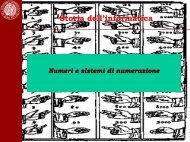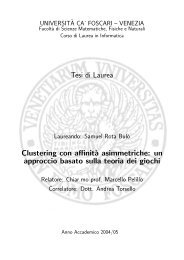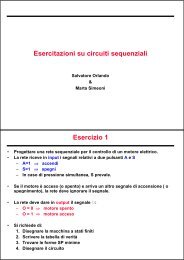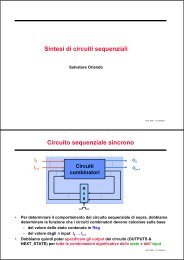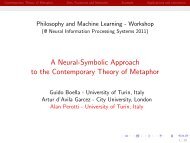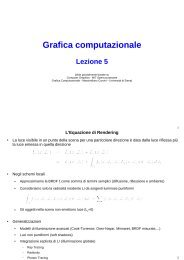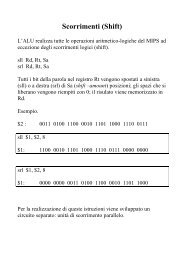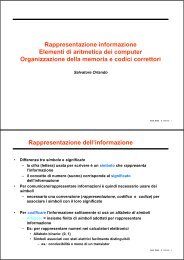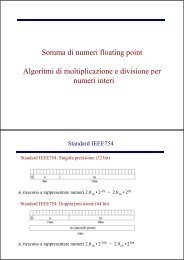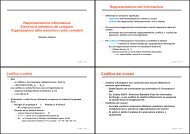Dispensa in PDF - Dipartimento di Scienze Ambientali, Informatica e ...
Dispensa in PDF - Dipartimento di Scienze Ambientali, Informatica e ...
Dispensa in PDF - Dipartimento di Scienze Ambientali, Informatica e ...
You also want an ePaper? Increase the reach of your titles
YUMPU automatically turns print PDFs into web optimized ePapers that Google loves.
g(){<br />
.<br />
.<br />
.<br />
y = f(3, obj);<br />
.<br />
.<br />
.<br />
}<br />
f(a,b){<br />
<strong>in</strong>t c;<br />
<strong>in</strong>t d;<br />
MyClass e;<br />
c = d = 1;<br />
e = b;<br />
e.a1 = 7;<br />
return e.a1;<br />
}<br />
(a)<br />
Dynamic Cha<strong>in</strong><br />
Carnielli Efrem: Programmazione a componenti<br />
Valore <strong>di</strong> return: 7<br />
a 3<br />
b<br />
c ⊥ 1<br />
d ⊥ 1<br />
e NULL<br />
Activation record<br />
<strong>di</strong> f<br />
Activation record<br />
<strong>di</strong> g<br />
Activation Stack<br />
Figura 3.3. Esempi <strong>di</strong> chiamata <strong>di</strong> una funzione.<br />
Pr<strong>in</strong>cipi <strong>di</strong> progettazione<br />
a1 7<br />
a2 1<br />
Memoria Heap<br />
(a) = <strong>in</strong><strong>di</strong>rizzo <strong>di</strong> ritorno<br />
In questo esempio la funzione g <strong>in</strong> esecuzione (ve<strong>di</strong>amo che l’activation record <strong>di</strong> g<br />
è già presente nell’activation stack) chiama la funzione f. Di conseguenza viene<br />
<strong>in</strong>serito nell’activation stack l’activation record <strong>di</strong> f che presenta i campi dei<br />
parametri passati e delle variabili. Il passaggio dei parametri viene effettuato per<br />
valore, qu<strong>in</strong><strong>di</strong> ve<strong>di</strong>amo che b assume il puntatore all’oggetto nella memoria Heap<br />
(frecce <strong>in</strong> blu). L’activation record memorizza anche l’<strong>in</strong><strong>di</strong>rizzo dell’istruzione<br />
successiva alla chiamata <strong>di</strong> f <strong>in</strong> g, ovvero y =valore <strong>di</strong> ritorno .<br />
Con l’esecuzione <strong>di</strong> f vengono mo<strong>di</strong>ficati i campi dell’activation record <strong>di</strong> f, <strong>in</strong><br />
particolare viene mo<strong>di</strong>ficato il valore <strong>di</strong> c e d, e punta all’oggetto puntato da b,<br />
viene mo<strong>di</strong>ficato un campo dell’oggetto e impostato il valore da ritornare a g (tutto<br />
visualizzato <strong>in</strong> rosso).<br />
Un altro importante elemento che potrebbe essere presente all'<strong>in</strong>terno<br />
dell'activation record a seconda del tipo <strong>di</strong> l<strong>in</strong>guaggio <strong>di</strong> programmazione che<br />
utilizziamo è lo static l<strong>in</strong>k.<br />
Il l<strong>in</strong>k statico che da orig<strong>in</strong>e alla static cha<strong>in</strong> è un puntatore al contesto della<br />
funzione, ovvero tutto ciò che viene utilizzato dalla funzione ma è locale ad essa;<br />
53





